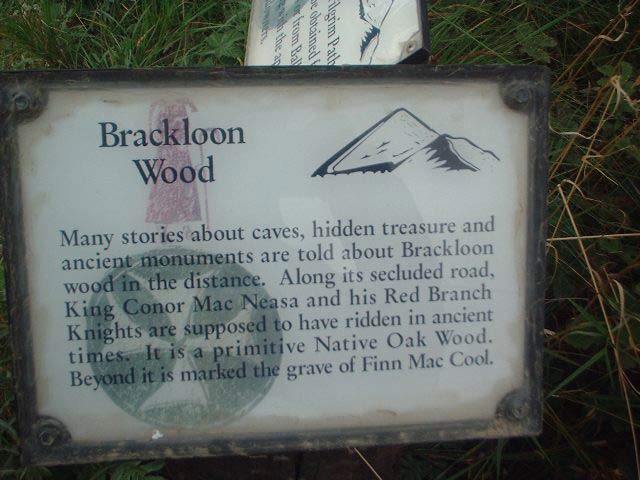Brackloon Wood is part of the Tóchar Phádraig/Patrick’s Causeway Bike Tour!
Brackloon Wood is an ancient and little-known place, not far from the remarkable Boheh Stone (where a 5,800-year old tablet was discovered in 2016). The 173-acre forest lies undisturbed and still in low hills on the eastern side of Croagh Patrick, its 200-year old Atlantic oak trees fringed with lichen and ferns. Yet these are just indicators of a much deeper past, when the entire area was covered with oak forest. This occurred after the glaciers started to recede from Ireland over 12,000 years ago, so that when the first humans arrived around three thousand years later, they found trees covering the lower lands around the more exposed mountainsides.
There are local stories of a Celtic past, of caves and monuments hidden in these woods. There are moss and bramble-covered standing stones found here. There is also a prominent ringfort and even a stone circle.
Other evidence of early human settlements is found here – several fulacta fiadh – a type of cooking pit constructed during the mid to late Bronze Age. These were usually constructed near streams or rivers, which provided the water to fill a stone or timber trough. Stones were heated on a nearby fire, and were then used to boil the water in the trough. Ringforts were built in Ireland during the early Christian period after 300 a.d. and were predominantly used for human habitation for hundreds of years. Earthen ringforts are called ‘raths’, while stone ones are referred to as ‘cashels’. These had as many as three concentric lines of ‘defense’ in the form of walls. The ringforts were used by humans and also as a shelter for animals. The ‘door’ to the fort was often built on the eastern side, away from the prevailing westerly winds. The ringfort in Brackloon Wood is a cashel, some 25 metres wide, located in the centre of the forest.

The 19th century author Thackeray called Brackloon “noble woods”. At that time, they were a part of Westport House Estate, owned by the Marquis of Sligo. Patrick’s Causeway or ‘Tóchar Phádraig‘ (click on the link to see post), passes close to the woods. This route predates Saint Patrick by many hundreds of years. It was believed to be a significant road capable of carrying wheeled traffic from Rathcroaghan (Cruachan) in County Roscommon – home of the High Kings of Connaught and the legendary Queen Maedhbh (Maeve) – to Cruachan Aigli (now Croagh Patrick).

Brackloon is found seven kilometres southwest of Westport town. It is one of the few deciduous forests surviving in modern Ireland.
Evidence of extensive prehistoric settlements in this area is already indicated by the presence of cairns on the shoulders of Croagh Patrick. These large burial mounds of earth or stone are thought by Archaeologist Leo Morahan to have their origin in the late Neolithic or early Bronze Age.

Brackloon has undergone many changes in the years since it was pristine forest. Significant clearance of woodlands took place in the 16th and 17th centuries, after the invention of the blast furnace. Colonel John Browne, who had acquired huge swathes of land in Ireland, built what is now referred to as Westport House and established an ironworks at the nearby village of Knappagh in 1687. At its peak, 150 men were employed in the making of cannonballs, iron and metal tools to British garrisons in Galway and the island of Inishbofin. The ironworks was fueled by charcoal produced from local timber. Much of the deforestation of Ireland occurred during the industrial age, when the country’s English overlords used the country as a source for timber and charcoal. This exploitation of woodland occurred over centuries, and later fast-growing conifers were introduced. These ‘intruders’ to the primeval forest were culled by the Forest Service in the late 1990s, as the State sought to restore it to its deciduous origins by planting oaks, birches, willows and ash trees.

Acknowledgement to Dr. Deirdre Cunningham for her detailed work on Brackloon Wood.

Comments are closed, but trackbacks and pingbacks are open.